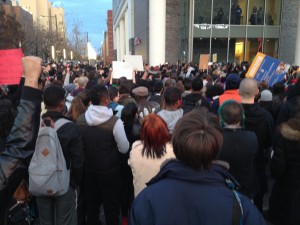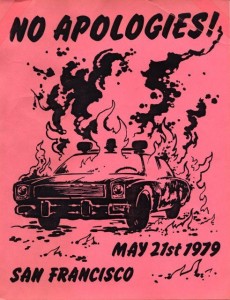On Ferguson and Queer Amnesia
BY Dan Royles ON December 2, 2014
 Like many Americans, I was sickened—but not shocked—by a Missouri grand jury’s failure to indict police officer Darren Wilson for the August 9th murder of Mike Brown. The miscarriage of justice in Ferguson triggered over 130 protests in 37 states the day after the grand jury’s announcement.
Like many Americans, I was sickened—but not shocked—by a Missouri grand jury’s failure to indict police officer Darren Wilson for the August 9th murder of Mike Brown. The miscarriage of justice in Ferguson triggered over 130 protests in 37 states the day after the grand jury’s announcement.
One of those cities was Philadelphia, where hundreds of protestors gathered at City Hall the evening of November 25th before marching up to Temple University at the intersection of Broad Street and Cecil B. Moore (formerly Columbia) Avenue. This was a significant destination, since the neighborhood was the site of a three-day riot just over fifty years ago, in August 1964. Then, anger over racist policing, economic inequality, and the slow pace of political change boiled over into a mass rebellion that ended in hundreds of arrests, two deaths, and millions of dollars in property damage.
Half a century later, much has changed, although the issues in Philadelphia remain largely the same. Last week, marchers carried signs decrying police violence against communities of color, of which Mike Brown’s murder is just one example. Using a portable loudspeaker, one mother described the pain of burying her son, a victim of police violence. Others connected the event to a broader set of local tensions. As the crowd milled beneath Morgan Hall, the 27-story dormitory opened a year ago by Temple University, march leaders railed against gentrification in the neighborhood. In recent years, Temple has worked to shed its commuter-school image with new construction and an increased police presence aimed at reassuring white suburban students (and their parents) that the campus is safe. At the same time, longtime residents of the predominantly black North Philadelphia neighborhood (like other citizens in New Brunswick, New York City and other communities slowly giving way to university expansion) feel squeezed out by the Temple’s expanding footprint and the rising rents that come along with it.
As in other cities, queer activists like myself joined the demonstration. Philadelphia has a long history of radical queer politics, including organizing by queer people of color, and a large contingent of queer folks a march that snaked its way for almost four miles down Broad Street, from Center City to North Philadelphia and back, chanting, “No justice, no peace, no racist police!” and, “Shut it down!”
But these historic, intersecting community commitments are not always reflected, or even acknowledged, in queer media. When I returned home from the march and browsed through my blog feed, I found a torrent of posts from prominent gay blogs like Towleroad and Joe. My. God. focused on federal rulings against same-sex marriage bans in Arkansas and Mississippi. No doubt these decisions, along with the tidal wave of gay marriage legalization over the past year, represent a measure of progress. But the jubilant posts about Arkansas and Mississippi contrasted sharply with the anger and urgency of the march, captured in the widespread protest hashtag #blacklivesmatter. (To their credit, Joe. My. God. also covered the press conference and events unfolding in Ferguson; Towleroad, much less.) The degree to which gay marriage has moved into the political mainstream just over the past few years has been truly striking. Many, including John d’Emilio writing for this blog, have questioned whether this assimilationist agenda has supplanted the more radical challenges to American seen in gay liberation and ACT UP.
Like the community surrounding Temple University, gay politics has been gentrified. In urban neighborhoods undergoing redevelopment, white gay men and lesbians are often gentrifiers, being courted by developers for because we boost property values. But the costs and benefits of gentrification are not shared equally among queer people. According to Christina Hanhardt, LGBT calls for protection from street violence have historically resulted in increasing privatization and police surveillance of gay urban space, so-called “safety measures” that occur at the expense of poor and minority queer people.
As historically gay neighborhoods, such as New York’s Christopher Street or Philadelphia’s Gayborhood, become increasingly gentrified, they become whiter, richer and even straighter. They also become the sites of increased police violence. The increased police presence means that transgender women and queer youth, and particularly people of color in both groups, find themselves increasingly targeted for police harassment and arrest. Transgender people, and transgender people of color in particular, face vastly disproportionate rates of police violence. A 2012 report by the National Coalition of Anti-Violence Programs found that transgender people of color were almost two and a half times as likely to face police violence as white non-transgender people, even when they themselves were reporting violence. Transgender women also report being targeted by law enforcement, who use condom possession as evidence them on prostitution charges. Furthermore, queer youth make up 40% of the nation’s homeless youth, which in turn leads many to incarceration.
Along with the gentrification of gay urban spaces, mainstream gay politics has experienced what scholar-activist Sarah Schulman calls “gentrification of the mind”—a collective forgetting of the hard-won, sometimes radical, struggle for rights and recognition pursued by earlier generations of queers. White, affluent gay men and lesbians have attained increased respectability and cultural capital, and may very well see the issues of police brutality and judicial prejudice coming to the fore in Ferguson as disconnected from their own lives.
But it was not so long ago that gay people of all colors were targeted by police, who set up stings in popular cruising spots and raided gay bars and private parties, notably during the “lavender scare” that gripped Washington, DC during the 1950s and 1960s. It was the violent, rebellious response to such policing at New York’s Stonewall Inn, led by queers of color, that marked a turning point in the modern gay rights movement. And when San Francisco supervisor Dan White was convicted of manslaughter rather than murder in the killing of gay politician Harvey Milk in 1978, the city’s Castro District erupted in rebellion. In the face of such a gross miscarriage of justice, white gay rioters clashed with local police and causing hundreds of thousands of dollars in property damage. After the riots, the group Lesbians Against Police Violence created a poster featuring an illustration of a burning police car with “NO APOLOGIES!” in bold text. One imagines that today Castro residents might tweet pictures of the smoke and destruction, tagged #gaylivesmatter.
Even more recently, during the first decade of the AIDS crisis, gay lives of all colors were still viewed as expendable. In the early 1980s, Ronald Reagan’s press secretary Larry Speakes and the White House press corps openly laughed about the growing AIDS epidemic. Reagan himself famously did not publicly comment on AIDS until 1987. By the end of that year, over forty thousand Americans had died of the disease. It took sustained direct action from AIDS activists, particularly ACT UP, to bring drug costs down and speed up the approvals process for new medications. ACT UP protests were non-violent by design, but they were not peaceful—instead, they were disruptive and angry. At times, the group’s unruly civil disobedience brought police repression, as when local police beat members of the Philadelphia chapter during a 1991 protest outside the Bellevue Hotel in Center City. But it was actions such as these that remade HIV into a chronic, manageable condition in the middle 1990s with the advent of protease inhibitors.
This rage is absent from contemporary gay politics, even as HIV and AIDS also continue to affect gay and bisexual men more than any other group. As with policing, here too people of color bear the brunt of the burden, despite roughly even rates of safer sex practices across racial lines. Black gay and bisexual men account for about one in four new HIV infections. According to the Black AIDS Institute’s 2012 report, “Back of the Line,” by age twenty-five a black gay man has a 25% chance of contracting HIV; by the time he reaches forty, that number goes up to 60%. But again, the policing that makes affluent gay neighborhoods “safe” targets young queers of color and considers the tools of HIV prevention—condoms—to be evidence of illegal activity.
It may be easy for LGBT people—particularly those who are white and affluent—to see themselves as removed from the events in Ferguson, or the larger issues of police violence and mass incarceration that have brought thousands out in protest since the grand jury’s decision. This distancing ignores the complicity of mainstream LGBT politics in these social ills, as claims on gay respectability have been premised on the marginalization of the poor, minorities, and trans people. Moreover, it erases our own history of being policed and offered up as expendable, along with our rebellious responses to injustice. As we accede to this amnesia as the price of mainstream acceptance, we not only forget our past—we become agents of oppression in the present.








